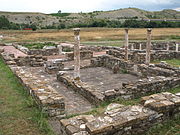Portal:North Macedonia/Places
| This page is currently inactive and is retained for historical reference. Either the page is no longer relevant or consensus on its purpose has become unclear. To revive discussion, seek broader input via a forum such as the village pump. |
| Note: Article entries are now being transcluded directly on the main portal page. However, this page should be retained for historical reference. |

Stobi (Macedonian: Стоби, today Gradsko; Ancient Greek: Στόβοι) was an ancient town of Paeonia, later conquered by Macedon, and later turned into the capital of the Roman province of Macedonia Salutaris (now in North Macedonia). It is located on the main road that leads from the Danube to the Aegean Sea and is considered by many to be the most famous archaeological site in North of Macedonia. Stobi was built where the Erigón river (mod. River Crna) joins the Axiós river (mod. Vardar), making it important strategically as a center for both trade and warfare. In September 2010, it was announced that part of a €53,000 grant by the US government for restoring and conserving landmarks around North Macedonia will be allocated to Stobi.
Stobi developed from a Paeonian settlement established in the Archaic period. Located on the northern side of a terrace, the early town covered an area of about 25,000 m2 (270,000 sq ft). Its proximity to the junction of the Erigón and Axiós rivers as well as its position in the fertile central Vardar valley allowed it quickly to develop a flourishing economy and to establish trade. Nearby Mount Klepa was a lucrative source of marble. The initial Paeonian population was later supplemented by other immigrant groups. It is believed that in 217 BCE, Philip V annexed Paionia during his campaign against the Dardans who had entered the largest Paionian town Bylazora. Since this moment Paionia and Stobi are considered part of the Macedonian region. (Read more...)
